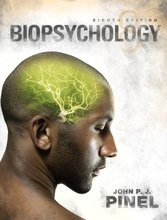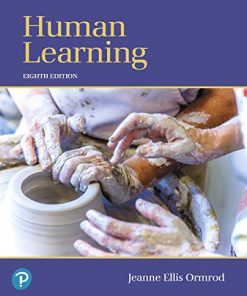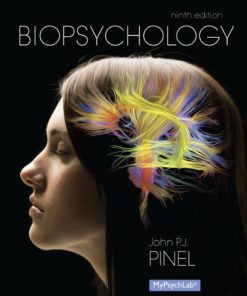Biopsychology Pinel 8th Edition Test Bank
$35.00 Original price was: $35.00.$26.50Current price is: $26.50.
Biopsychology Pinel 8th Edition Test Bank
Biopsychology Pinel 8th Edition Test Bank

Product details:
- ISBN-10 : 0205832563
- ISBN-13 : 978-0205832569
- Author: John Pinel
The defining feature of Biopsychology is its unique combination of biopsychological science and personal, reader-oriented discourse. Rather than introducing biopsychology in the usual textbook fashion, it interweaves the fundamentals of the field with clinical case studies, social issues, personal implications, and humorous anecdotes. It tries to be a friendly mentor that speaks directly to the reader, enthusiastically relating recent advances in biopsychological science.
Table contents:
- 1. Biopsychology As a Neuroscience: What Is Biopsychology, Anyway?
- What Is Biopsychology?
- What Is the Relation Between Biopsychology and the Other Disciplines of Neuroscience?
- What Types of Research Characterize the Biopsychological Approach?
- What Are the Divisions of Biopsychology?
- Converging Operations: How Do Biopsychologists Work Together?
- Scientific Interference: How Do Biopsychologists Study the Unobservable Workings of the Brain?
- Critical Thinking About Biopsychological Claims
- 2. Evolution, Genetics, and Experience: Thinking About the Biology of Behavior
- Thinking About the Biology of Behavior: From Dichotomies to Relations and Interactions
- Human Evolution
- Fundamental Genetics
- Behavioral Development: The Interaction of Genetic Factors and Experience
- The Genetics of Human Psychological Differences
- 3. The Anatomy of the Nervous System: The Systems, Structures, and Cells That Make Up Your Nervous System
- General Layout of the Nervous System
- Cells of the Nervous System
- Neuroanatomical Techniques and Directions
- Spinal Cord
- The Five Major Divisions of the Brain
- Major Structures of the Brain
- 4. Neural Conduction and Synaptic Transmission: How Neurons Send and Receive Signals
- The Neurons Resting Membrane Potential
- Generation and Conduction of Postsynaptic Potentials
- Integration of Postsynaptic Potentials and Generation of Action Potentials
- Conduction of Action Potentials
- Synaptic Transmission: Chemical Transmission of Signals from One Neuron to Another
- The Neurotransmitters
- Pharmacology of Synaptic Transmission
- 5. The Research Methods of Biopsychology: Understanding What Biopsychologists Do
- Methods of Visualizing the Living Human Brain
- Recording Human Psychophysiological Activity
- Invasive Physiological Research Methods
- Pharmacological Research Methods
- Genetic Engineering
- Neuropsychological Testing
- Behavioral Methods of Cognitive Neuroscience
- Biopsychological Paradigms of Animal Behavior
- 6. The Visual System: From Your Eyes to Your Cortex
- Light Enters the Eye and Reaches the Retina
- The Retina and Translation of Light into Neural Signals
- From Retina to Primary Visual Cortex
- Seeing Edges
- Seeing Color
- 7. Mechanisms of Perception, Conscious Awareness, and Attention: How You Know the World
- Principles of Sensory System Organization
- Cortical Mechanisms of Vision
- Audition
- Somatosensation: Touch and Pain
- The Chemical Senses: Smell and Taste
- Selective Attention
- 8. The Sensorimotor System: How You Do What You Do
- Three Principles of Sensorimotor Function
- Sensorimotor Association Cortex
- Secondary Motor Cortex
- Primary Motor Cortex
- Cerebellum and Basal Ganglia
- Descending Motor Pathways
- Sensorimotor Spinal Circuits
- Central Sensorimotor Programs
- 9. Development of the Nervous System: From Fertilized Egg to You
- Phases of Neural Development
- Postnatal Cerebral Development in Human Infants
- Effects of Experience on Neural Development
- Neuroplasticity in Adults
- Disorders of Neurodevelopment: Autism and Williams Syndrome
- 10. Brain Damage and Neuroplasticity: Can the Brain Recover from Damage?
- Causes of Brain Damage
- Neuropsychological Diseases
- Animal Models of Human Neuropsychological Diseases
- Neuroplastic Responses to Nervous System Damage: Degeneration, Regeneration, Reorganization, and Recovery
- Neuroplasticity and the Treatment of Nervous System Damage
- 11. Learning, Memory, and Amnesia: How Your Brain Stores Information
- Amnesic Effects of Bilateral Medial Temporal Lobectomy
- Amnesia of Korsakoffs Syndrome
- Amnesia of Alzheimers Disease
- Amnesia After Concussion: Evidence for Consolidation
- Neuroanatomy of Object-Recognition Memory
- Hippocampus and Memory for Spatial Location
- Where Are Memories Stored? Synaptic Mechanisms of Learning and Memory
- Conclusion: Infantile Amnesia and the Man Who Remembered Nothing but H.M
- 12. Hunger, Eating, and Health: Why Do Many People Eat Too Much? Digestion and Energy Flow
- Theories of Hunger and Eating: Set Points Versus Positi
People also search:
Biopsychology
Biopsychology Pinel
Biopsychology Pinel 8th
Biopsychology Pinel 8th Test Bank
Biopsychology Pinel 8th Edition Test Bank
You may also like…
Test Bank
Test Bank












